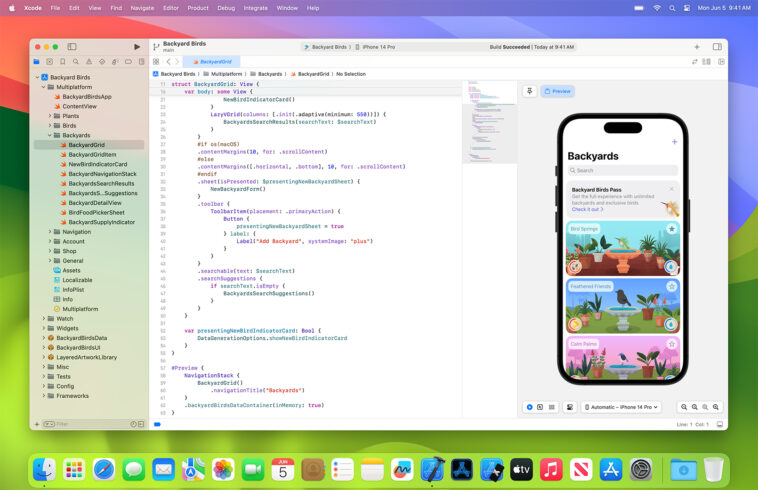Apple hosted an event on September 12 at the company’s home in Cupertino. The event unveiled a lineup of new devices, including the iPhone 15 and iPhone 15 Pro, the Apple Watch Series 9, and the Apple Watch Ultra 2. Rumors of new iMac and MacBook Pro models were also mentioned, with no sign of the rumored iPad mini 7. Apple also mentioned its commitment to eliminating leather from its cases and Watch bands as part of its sustainability goals for 2030.
The same day, Apple shared the news of releasing its latest operating systems, including iOS 17, iPadOS 17, macOS Sonoma, tvOS 17, and watchOS 10, to users worldwide. For app developers, this signals a crucial time to prepare their creations for these upcoming platforms. Here’s what you need to know:
1. Equipping Yourself with the Right Tools:
Before diving into the development process, ensure you have the necessary tools at your disposal. Apple recommends using the Xcode 15 Release Candidate and the latest Software Development Kits (SDKs). These tools are essential for building and optimizing your apps and games.
Additionally, Apple encourages developers to test their applications using TestFlight. This platform provides a controlled environment for testing your creations, ensuring they function seamlessly on the new operating systems.
2. Navigating the App Submission Process:
Once your apps are polished and ready for the public eye, it’s time to submit them for review to the App Store. This step is crucial in making your apps available to users. Fortunately, Apple has streamlined this process by allowing developers to deploy their apps directly from Xcode Cloud to TestFlight and the App Store.
3. Embracing New Possibilities:
Apple’s latest operating systems introduce a host of exciting features and significant enhancements across various aspects of app development. These updates open doors to creating more unique and engaging experiences for users on Apple platforms.
4. Xcode and Swift:
Xcode 15 is designed to expedite app development. It offers improved code completion, interactive previews, and live animations, allowing developers to code and design apps more efficiently. Swift, Apple’s programming language, has also received enhancements. It introduces macros for crafting more expressive and intuitive APIs. The SwiftData framework simplifies data persistence through declarative code. Furthermore, SwiftUI now supports advanced animations and streamlined data flows with the Observation framework.
5. Widgets and Live Activities:
Widgets have undergone significant improvements. They are now interactive and can be placed in various locations, enhancing their usability. SwiftUI ensures widgets adapt their appearance based on context, making them versatile across different Apple devices. Live Activities, created with WidgetKit and ActivityKit, are now accessible on iPad, allowing users to stay updated with real-time app content.
6. Enhancements in Metal:
For game developers, Apple has introduced a game porting toolkit to simplify the process of bringing games to Mac. The Metal shader converter streamlines the adaptation of your game’s graphics code. Updates in ray tracing enable the creation of more realistic and detailed in-game scenes. These Metal enhancements facilitate the development of exceptional games and professional apps optimized for Apple silicon.
7. App Shortcuts:
App Shortcuts provide a convenient way to make your app’s key features accessible through Spotlight. A redesigned interface simplifies the execution of app shortcuts, and natural language capabilities empower users to initiate shortcuts using voice commands.
8. App Store Improvements:
The App Store has not been left untouched. SwiftUI views integrated into StoreKit make it easier for developers to merchandise in-app purchases and subscriptions across all platforms. Testing your product offerings has also become more convenient with enhancements to StoreKit testing in Xcode, the Apple sandbox environment, and TestFlight. Furthermore, developers can generate excitement by launching their apps in different regions with pre-orders by region. The App Store now offers a more personalized app discovery experience, helping users find apps tailored to their interests and preferences.
In conclusion, Apple’s forthcoming operating system updates bring a wealth of opportunities for app developers. By leveraging the latest tools and embracing the enhancements, developers can ensure their apps are not only compatible but also optimized for these new platforms.
In addition, very recently, Apple sent out invitations to developers for a free app optimization workshop at its Apple Developer Center. Also, the company announced that iPhone and iPad apps will be readily accessible on the visionOS’ App Store upon its launch.







Comments
Loading…